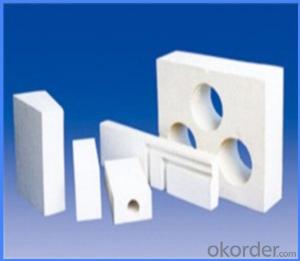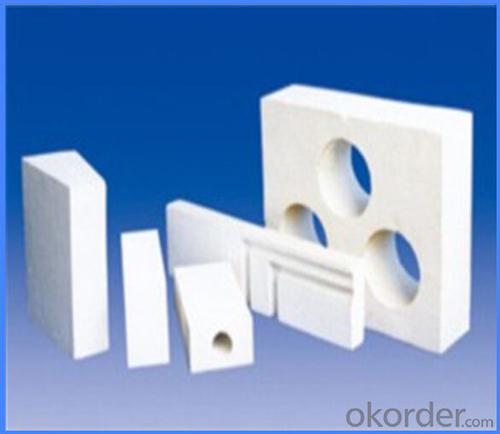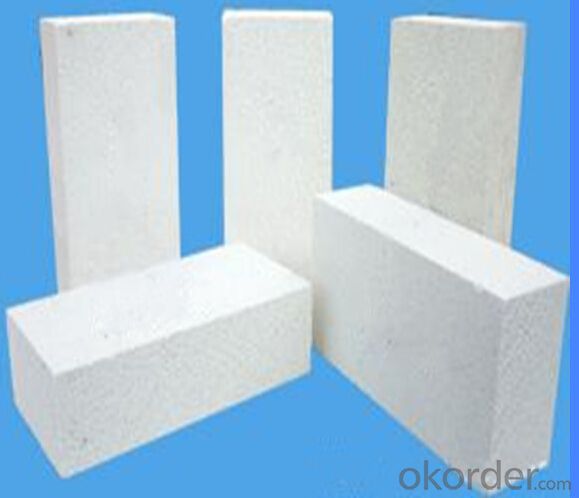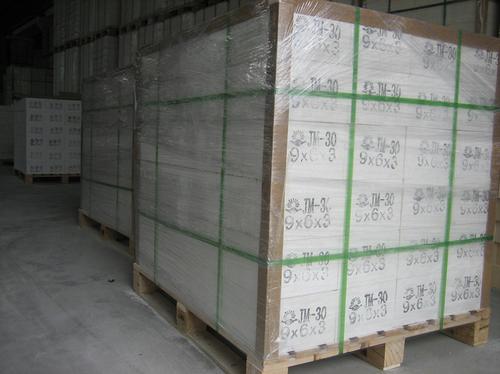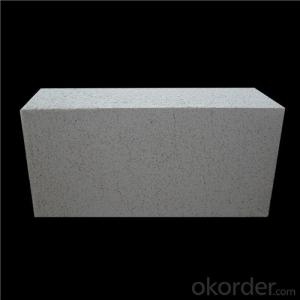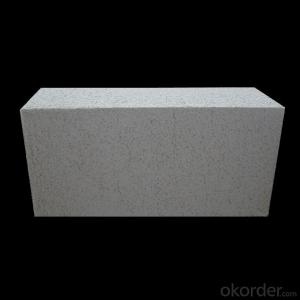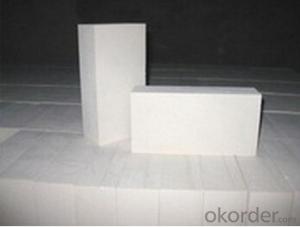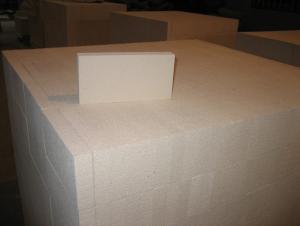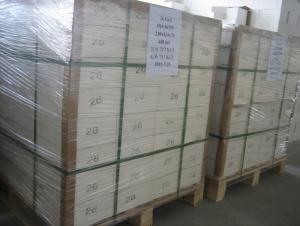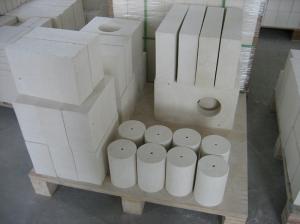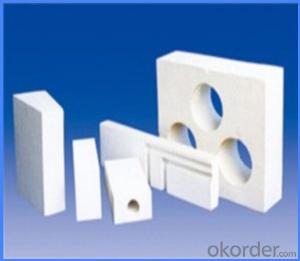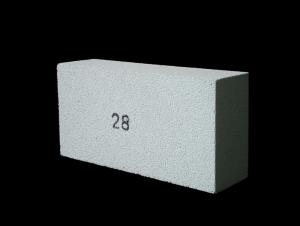Insulating Fire Brick - Refractory Mullite Insulating Refractory Brick JM 41
- Loading Port:
- Shanghai
- Payment Terms:
- TT OR LC
- Min Order Qty:
- 20 m.t.
- Supply Capability:
- 20 m.t./month
OKorder Service Pledge
OKorder Financial Service
You Might Also Like
General Information
CMAX insulating firebricks are classified under temperature between 1300℃ to 1700℃, manufactured from high purity alumina clay.
1. Lower content of iron, alkaline and impurities, good high temperature properties.
2. Homogeneous structure, light weight, energy saving because lower heat storage in the furnace during cooling cycles.
3. High strength, good thermal shock resistance under high temperature.
4. Precise sizes due to grinding and shaping after sintering, which meets the requirement of construction.
5. Max service temp: Up to 1730C (3160F)
Feature
Light weight and low thermal conductivity
Low heat storage
Low iron and impurities
High thermal shock resistance
Application of Insulating brick
Metallurgical Industry: blast furnace, hot blast furnace, heating furnace, etc..
Petrochemical Industry: ethylene cracking furnace, hydrogen furnace, the main furnace, heating furnace, etc..
Ceramic industry: roller kiln, kiln, etc..
Glass industry: glass furnace regenerator, etc.
Carbon industry: carbon furnace, etc..
Aluminum electrolysis industry: aluminum reduction cell, etc.
Other industries: tunnel kiln, shuttle kiln, etc.
Advantages of heat insulation brick
Low thermal conductivity: many air holes will bring good thermal insulation effect, energy saving.
High crushing strength: high crushing strength, volume stability.
Low heat storage: small heat storage, absorb more heat, energy-saving effect is obvious.
Technical Data
ITEM | GJM30 | GJM28 | GJM26 | GJM23 |
Classification Temperature, ℉/℃ | 3000/1650 | 2800/1540 | 2600/1430 | 2300/1260 |
Bulk Density,g/cm³ | ≤1.0 | ≤0.9 | ≤0.8 | ≥0.5 |
Reheating Linear Change, % | ≤0.9 (1550℃,12 h) | ≤0.8 (1510℃,12 h) | ≤0.7 (1410℃,12 h) | ≤0.5 (1230℃,12 h) |
Al2O3 Content, % | ≥75 | ≥65 | ≥55 | ≥45 |
Fe2O3 Content, % | ≤0.5 | ≤0.6 | ≤0.7 | ≤1.0 |
Thermal Conductivity: | ||||
800℃, w/m.k | ≤0.39 | ≤0.37 | ≤0.35 | ≤0.18 |
1000℃, w/m.k | ≤0.43 | ≤0.41 | ≤0.39 | ≤0.20 |
1200℃, w/m.k | ≤0.48 | ≤0.46 | ≤0.43 | --- |
Insulating brick
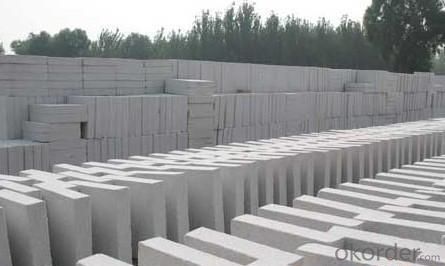
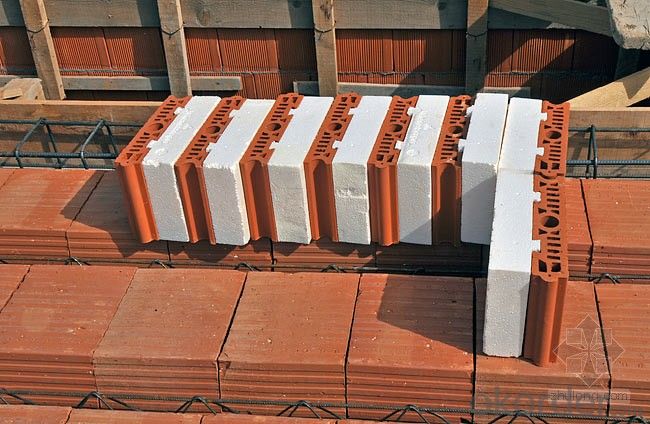
Common problem solution
1. What products do you have?
We have all kinds of refractory bricks, refractory casting materials, mortar, cement, ceramic fiber products, etc..
Or you can browse our products to choose what you need.
2. How to control product quality?
With strict quality control system throughout the material selection and production process, we have the quality of refractory materials and ceramic fiber products to meet customer requirements.
From the selection of raw materials, the quality of our control to start. The quality of the raw materials required for each batch of products in the use of the front line test. In the production process, through the quality control of workers, and then to each piece of classification, and through quality supervision and inspection.
3. Could you give me a brief introduction to the application of your product?
My Company is mainly engaged in steel, cement, glass, ceramics, petrochemical, electric power and other industries.
4. If I need you, what kind of information do you need?
In order to select the right products, we will provide us with information, such as the United States, technical data, order quantity, product applications, etc..
If you have any questions, please contact us.
- Q: Are insulating fire bricks resistant to carbon dioxide?
- Insulating fire bricks, also known as refractory bricks, are designed to withstand high temperatures and are generally resistant to various chemicals and gases. However, their resistance to carbon dioxide may vary depending on the specific type and composition of the insulating fire brick. Carbon dioxide (CO2) is a non-flammable gas that is usually present in the atmosphere and is released during the combustion of carbon-based fuels. In most cases, insulating fire bricks have a high resistance to carbon dioxide due to their high melting point and the presence of refractory materials such as alumina and silica. However, prolonged exposure to high concentrations of carbon dioxide, especially at elevated temperatures, can cause some insulating fire bricks to undergo chemical reactions that may lead to degradation or reduced performance. It is important to consider the specific application and environment in which the insulating fire bricks will be used. If the insulating fire bricks are part of a furnace or kiln that generates significant amounts of carbon dioxide, it is advisable to choose bricks specifically designed for such conditions. These bricks may have additional protective coatings or higher chemical resistance to ensure their longevity and performance. In summary, while insulating fire bricks generally have good resistance to carbon dioxide, it is important to consider the specific type of brick and the conditions under which it will be used to ensure optimal performance and longevity.
- Q: Are insulating fire bricks resistant to acid or alkali attacks?
- Insulating fire bricks are generally resistant to acid attacks but may not be highly resistant to alkali attacks.
- Q: Are insulating fire bricks resistant to abrasion or erosion?
- Yes, insulating fire bricks are resistant to both abrasion and erosion.
- Q: Do insulating fire bricks expand and contract with temperature changes?
- Yes, insulating fire bricks do expand and contract with temperature changes. Like any material, when exposed to heat, the insulating fire bricks expand, and when cooled, they contract. This expansion and contraction occur due to the thermal expansion coefficient of the material, which determines how much it will expand or contract for a given change in temperature. It is important to consider this property when using insulating fire bricks in applications where temperature fluctuations are expected, as failure to account for the expansion and contraction may lead to structural damage or cracking.
- Q: Can insulating fire bricks be used in the construction of pottery molds?
- Yes, insulating fire bricks can be used in the construction of pottery molds. Insulating fire bricks are designed to withstand high temperatures and provide excellent heat insulation, making them suitable for pottery molds that require heating in kilns. They can help retain heat and distribute it evenly, resulting in better firing and glazing of pottery.
- Q: Are insulating fire bricks resistant to flame impingement?
- Yes, insulating fire bricks are resistant to flame impingement.
- Q: How do insulating fire bricks help improve the efficiency of heating systems?
- The utilization of insulating fire bricks plays a critical role in enhancing the efficiency of heating systems through the provision of exceptional thermal insulation. These bricks are specifically engineered to possess a low thermal conductivity, thereby minimizing the transfer of heat from the heating system to its surroundings. By incorporating insulating fire bricks, the heat generated by the heating system is effectively contained within the system itself, resulting in a more efficient heating process. This is particularly significant in scenarios prioritizing energy conservation, as it aids in reducing heat loss and minimizing energy wastage. Furthermore, insulating fire bricks exhibit remarkable heat retention capabilities, enabling them to store and emit heat for prolonged durations. This attribute allows the heating system to maintain a consistent and stable temperature, ultimately leading to improved comfort and reduced energy consumption. Moreover, insulating fire bricks also exhibit exceptional resistance to thermal shock, meaning they can endure sudden temperature fluctuations without cracking or breaking. This durability ensures the longevity of the heating system and reduces the necessity for frequent repairs or replacements, thereby further enhancing its overall efficiency. In conclusion, insulating fire bricks contribute significantly to the enhancement of heating system efficiency by diminishing heat loss, improving heat retention, and providing durability against thermal shock. By harnessing the benefits of these bricks, heating systems can operate more effectively, consume less energy, and offer superior comfort.
- Q: Are insulating fire bricks resistant to salt attack?
- Insulating fire bricks are not typically resistant to salt attack. Salt attack refers to the corrosion and degradation of materials when exposed to salt or saltwater. While insulating fire bricks are designed to have excellent thermal insulation properties, they are not specifically formulated to withstand the corrosive effects of salt. Salt attack can lead to the breakdown of the bricks' structure, reducing their performance and durability over time. If these bricks are regularly exposed to salt or saltwater, it is likely that they will experience accelerated degradation and may not provide long-term reliability in such environments. To ensure resistance to salt attack, it is recommended to use refractory materials specifically designed for this purpose, such as salt-resistant fire bricks or refractories with higher alumina content. These materials have been developed to withstand the corrosive effects of salt and are more suitable for applications where exposure to salt or saltwater is expected.
- Q: Are insulating fire bricks suitable for use in the construction of drying ovens?
- Yes, insulating fire bricks are suitable for use in the construction of drying ovens. Insulating fire bricks are designed to have low thermal conductivity, which means they can effectively retain heat within the oven. This property is especially important in drying ovens as it helps to maintain a consistent and even temperature throughout the drying process. Additionally, insulating fire bricks have high resistance to thermal shock, meaning they can withstand the rapid temperature changes that may occur during the heating and cooling cycles of the oven. This durability ensures that the bricks will not crack or break under extreme temperature conditions. Furthermore, insulating fire bricks are lightweight and easy to handle, making them convenient for installation in drying ovens. Overall, these bricks provide excellent insulation and thermal stability, making them a suitable choice for the construction of drying ovens.
- Q: How do insulating fire bricks affect the overall energy savings of a structure?
- The overall energy savings of a structure can be greatly enhanced by using insulating fire bricks. These specialized bricks are designed with low thermal conductivity, effectively preventing heat transfer. By incorporating insulating fire bricks into the construction, heat loss through walls, floors, and ceilings is significantly reduced. One of the main ways these bricks contribute to energy savings is by improving the structure's insulation. With their high resistance to heat flow, insulating fire bricks help maintain a consistent indoor temperature. This reduces the need for artificial heating or cooling, as the bricks keep the interior warmer in colder months and cooler in hotter months. As a result, reliance on HVAC systems is reduced, resulting in substantial energy savings. Furthermore, insulating fire bricks also minimize thermal bridging, which occurs when materials with high thermal conductivity create pathways for heat to escape or enter the building. By using bricks with low thermal conductivity, these pathways are disrupted, greatly reducing heat transfer. This ensures that the building's insulation remains intact and minimizes energy loss. In addition, insulating fire bricks improve the efficiency of heating appliances. By lining the interior of fireplaces, furnaces, or kilns with these bricks, the heat generated is efficiently contained, leading to better heat distribution and reduced waste. This means less energy is required to achieve desired heating levels, resulting in increased energy savings. Overall, insulating fire bricks have a significant impact on energy savings for a structure. They enhance insulation, minimize thermal bridging, and improve the efficiency of heating appliances. By reducing heat loss and optimizing heating and cooling systems, these bricks greatly decrease energy consumption, leading to long-term cost savings and a more sustainable building.
Send your message to us
Insulating Fire Brick - Refractory Mullite Insulating Refractory Brick JM 41
- Loading Port:
- Shanghai
- Payment Terms:
- TT OR LC
- Min Order Qty:
- 20 m.t.
- Supply Capability:
- 20 m.t./month
OKorder Service Pledge
OKorder Financial Service
Similar products
Hot products
Hot Searches
Related keywords
